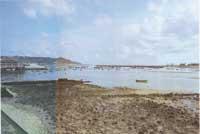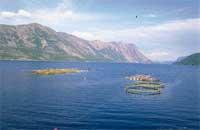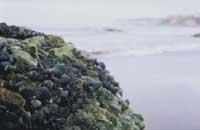Estuaries and humans
1996/09/01 Villate, Fernando Iturria: Elhuyar aldizkaria
Use of estuaries
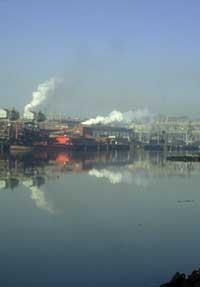
As in the rest of the ecosystems, it formerly acted as a human predator in estuaries and proof of this is the accumulation of mussels that have been found in prehistoric deposits near the estuaries. But with human development, the use of estuaries has been growing and diversifying over the centuries, especially in developed territories. Today, as is clearly seen, this influence has been especially negative for estuaries, as it has caused habitat destruction and the disappearance of species.
Estuaries, over the centuries, have attracted large human groups and, taking into account the resources offered by these areas, it is not surprising; at the beginning, it was observed that they are fertile places to obtain food, then they have been areas of navigation and commerce and in recent centuries have been suitable areas for the implementation of the industry. Thus, today, most major cities in developed countries are located in estuarine areas such as London, New York, Tokyo, Shanghai, Buenos Aires or Los Angeles. On the other hand, estuaries that have been left out of human massification are being integrated into the tourist network, so the infrastructures that demand leisure begin to affect the natural environment of the estuaries.
The use related to the transport of goods is very old, since tidal currents helped navigate and estuaries offered shelters to store ships and build docks. But the development of navigation meant an increase in ships and ports. The need to carry out dredging tasks that allow the passage of increasing boats has made some communities disappear in many estuaries. In some cases, in addition, the depth of the estuaries is not usually sufficient for the large vessels, such as the oil ones, and before that new and gigantic port constructions have been built in the mouth of the estuaries, leaving the interior for its notoriety and carrying the transport actions to the outside. The closest example is in the estuary of Bilbao, which although the port was in a high estuary next to the city, had to move outside the Abra.
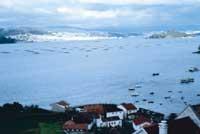
The analysis of industrial activity reveals that the destructive effect of the industrial revolution in developed countries has been evident. Large-scale industries (metallurgy, refineries, chemical industry, etc.) they needed plain areas and transport brakes, so they were mainly used for estuaries. The industrial implantation has promoted on the one hand the widening of the harbour structures mentioned above. On the other hand, for the expansion of the workshops that demanded a greater surface, the important mareal plains were covered in the estuaries. Today, industrial and urban expansion has led to the loss of 90% of the intertidal plains of some estuaries, along with the destruction of intertidal habitats and the disappearance of fish and birds fed in them.
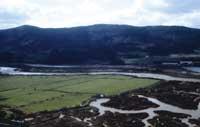
In addition, the solid and liquid waste generated by the cities and industries of the area is usually poured into the estuaries causing three types of pollution: that of inorganic food, that of organic matter and toxic substances. The increase in inorganic foods such as soap phosphates and organic matter such as food and stool residues, cause a process called eutrophication to begin, encouraging the growth of community production.
However, when the load of food is too high, the result is highly harmful, mainly due to the increased activity of decomposing bacteria, which means a decrease in oxygen in the water, making the environment uninhabitable for most animals. Industrial pollution consists mainly in the dumping of toxic chemicals for living things (phenols, organohalogenates, heavy metals, etc. ). Many of these substances can be lethal even at very low concentrations.
The use of fishmongers, marshlands and leisure, in addition to this use, can cause changes in the structure and operation of estuaries. To cope with the reduction of the natural populations of fish (especially flat fish) and seafood (shrimp, crabs, clams, oysters, mussels...), due to the increase of conventional catches, an aquaculture has been developed in some estuaries. Among the most important crops are mussels, especially in Galician rias, and oysters.
As for human leisure, the offer in estuaries is very wide. The flooded areas are ideal for sports navigation, swimming, wind-surfing, etc., activities that have often been accompanied by the construction of marinas. Sport fishing and bird watching are other leisure activities common in estuaries.
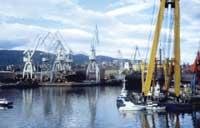
In general, the use of an estuary is usually very varied, but although many of them are compatible, some of them are incompatible, causing disturbances between interests. For example, the demands of aquacultures or conservationists could hardly join the intentions of the industry, highlighting the need for the management of this environment.
Management and conservation of estuaries
Seeing that estuaries are ecosystems of high value but very fragile and in most cases very punished, some governments and scientific and conservative societies have assumed in recent years the protection and/or recovery of estuaries. Proof of this responsibility has been, among others, the Ramsar Convention signed in 1971 for the protection of wetlands of international importance. Other important steps in the conservation of estuaries are the Berne Treaty for the Protection of European Wildlife and Natural Habitats, the Bonn Treaty for the Conservation of Migratory Species and the Biosphere Reserve Declaration. In the latter case, the Mundaka estuary is the main axis of the nearest Urdaibai Biosphere Reserve. Community regulations on plant and animal protection will also serve the conservation of estuarine communities.
If the human being wants to live in harmony with nature, the management of estuaries must also be oriented towards this goal. However, estuary management plans must approve three important requirements. The first, that most of the big cities of the world have developed on the sides of the estuaries, the second, that in most of the big estuaries of the world the pollution is high and the third, that the estuaries are among the most productive ecosystems of the world.
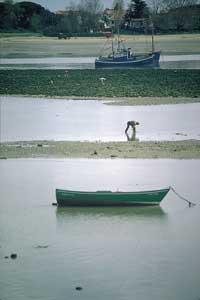
In general, for the management of estuaries, at least future uses must be taken into account: waste disposal generated in cities and industrial estates, commercial and craft fishing, navigation, tourism and leisure, water supply for agricultural and industrial use and nature conservation. Regarding the quality of the environment, what can guarantee the health of the estuary is the persistence of human uses, the duration of the biota necessary for fishing and the seafood industry, the capacity of activity of migratory fish and birds and not exceed the level of chemical and/or microbiological pollution that may be harmful to man or other beings.
The first practical steps to achieve this in highly degraded estuaries are the reduction of polluting discharges and the paralysis of occupation of the intertidal plains. However, we have taken the most important step: we have realized that estuaries and their beings are key elements of natural heritage. From now on, great work is being done, and in the long run, to correct the damage that has occurred in estuaries in such a short time, and to establish and implement the necessary measures to minimize the condition to estuaries in the future. But it is a hopeful job.

Gai honi buruzko eduki gehiago
Elhuyarrek garatutako teknologia



